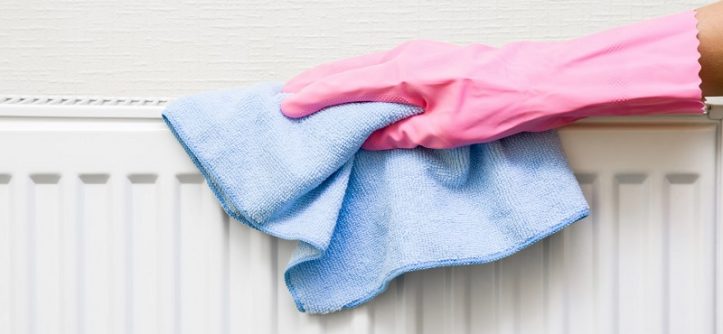Radiators are an essential part of many homes, providing warmth and comfort during the colder months. However, over time, they can accumulate dust, dirt, and grime, diminishing their efficiency and appearance. If you’re tired of looking at your dirty radiators and want to explore an unconventional yet surprisingly effective method for cleaning them, you’re in the right place. In this article, we’ll delve into the world of cleaning radiators with fabric softener—a technique that might just revolutionize your cleaning routine.
The Radiator Dilemma: A Common Household Challenge
Radiators, while incredibly useful, often pose a cleaning challenge. Their intricate design, with multiple fins and crevices, makes them prone to collecting dust and debris. Moreover, radiators can become grimy due to the natural circulation of air, which carries particles and even pet hair into their inner workings. Over time, this build-up can affect their efficiency, leading to higher energy consumption and less effective heating. Explore does clove oil kill bed bugs.
The Unexpected Solution: Fabric Softener
Believe it or not, one of the most effective solutions for tackling the grime on radiators is hiding in your laundry room: fabric softener. This common household item, usually reserved for making clothes soft and static-free, has properties that can aid in breaking down and loosening the stubborn dirt on your radiators.
How Does Fabric Softener Work?
Fabric softener contains a blend of chemicals designed to soften fabrics and reduce static cling. These same properties can be harnessed for radiator cleaning. The lubricating and anti-static agents present in fabric softener work to loosen dirt and grime, making them easier to wipe away. Additionally, the pleasant fragrance can leave your radiators smelling fresh after cleaning.
The Step-by-Step Guide to Cleaning Radiators with Fabric Softener
Cleaning your radiators with fabric softener is a straightforward process that can yield impressive results. Here’s a step-by-step guide to help you achieve a cleaner and more efficient heating system:
Step 1: Gather Your Supplies
Before you begin, gather the following supplies:
- Fabric softener (liquid form)
- Water
- Spray bottle
- Soft cloth or microfiber towel
Step 2: Dilute the Fabric Softener
In a spray bottle, mix equal parts of water and fabric softener. This dilution ensures that the solution isn’t too concentrated, preventing any potential damage to the radiator’s surface.
Step 3: Turn Off the Radiator
For safety reasons, it’s important to turn off the radiator before cleaning. This prevents any accidental contact with hot surfaces and allows the radiator to cool down.
Step 4: Apply the Solution
Spray the diluted fabric softener solution onto the radiator’s surface, targeting areas with visible dirt or grime. Allow the solution to sit for a few minutes, giving it time to break down the dirt.
Step 5: Wipe Away the Grime
Using a soft cloth or microfiber towel, gently wipe away the softened dirt and grime. The combination of fabric softener and the cloth’s texture should make the cleaning process relatively easy.
Step 6: Repeat if Necessary
For heavily soiled radiators, you may need to repeat the process to achieve the desired level of cleanliness. Simply spray the solution, wait, and wipe until the radiator is clean.
The Benefits of Using Fabric Softener for Radiator Cleaning
Cleaning radiators with fabric softener offers several benefits that can make this method a go-to solution for your cleaning needs:
- Gentle on Surfaces: Fabric softener is typically safe for various surfaces, including metal and painted finishes. This means you can use it without worrying about causing damage to your radiators.
- Efficient Cleaning: The lubricating properties of fabric softener help break down dirt and grime, making it easier to remove. This can save you time and effort compared to traditional scrubbing methods.
- Pleasant Fragrance: Unlike some harsh cleaning chemicals, fabric softener leaves a pleasant fragrance behind. This can help improve the overall ambiance of the room where the radiator is located.
FAQs
- Can I use any type of fabric softener for cleaning radiators?
Yes, most liquid fabric softeners should work effectively for this purpose. However, it’s a good idea to perform a patch test on a small, inconspicuous area of the radiator before applying the solution more broadly.
- How often should I clean my radiators with fabric softener?
The frequency of cleaning depends on factors such as the level of dust in your environment and how often you use your radiators. As a general guideline, aim to clean them at least once or twice a year.
- Will fabric softener damage the paint on my radiators?
If your radiators have a painted finish, the diluted fabric softener solution is unlikely to cause any damage. However, as mentioned earlier, it’s best to perform a patch test to be sure.
- Can I use this method for cleaning radiators with intricate designs?
Yes, the fabric softener solution can penetrate into the crevices of intricate radiator designs, helping to loosen dirt and grime. Be sure to use a soft cloth or microfiber towel to effectively clean these areas.
- Is there an alternative to fabric softener for radiator cleaning?
While fabric softener is effective, you can also consider using a mixture of mild dish soap and water for a similar cleaning effect. Test the solution on a small area before applying it more widely.
In conclusion, cleaning radiators with fabric softener might just be the innovative solution you’ve been searching for. With its gentle yet effective cleaning properties, fabric softener can help restore the efficiency and appearance of your radiators. So, the next time you’re faced with dirty radiators, give this method a try and enjoy the benefits of a cleaner and cozier living space
Tags: cleaning radiators, cleaning radiators with fabric softener, how does fabric softener work




Leave a Reply